How to achieve a perfect fit for crowns and bridges
Current laboratory surveys and past data collected indicate that between 70-80 percent of the cases received are for single-unit crown and bridge prostheses.
Current laboratory surveys and past data collected indicate that between 70-80 percent of the cases received are for single-unit crown and bridge prostheses.
Some laboratories have indicated that the number of remakes has increased from 6 percent to as high as 10 percent. With the advent and incorporation of better materials and techniques into our practices, this should not be the case.
The dual-arch impression is indicated for one or two crown and bridge units in an occlusion that is cuspid rise and relatively intact, and is generally contra-indicated for a terminal tooth preparation in the arch or group function occlusions.
It is simpler, more economical and cost effective in materials and time, is easier for the patient with less gagging potential, and has the potential for more accurate intercuspal relationships than mounted casts from single-arch impressions (12 times more accurate than full arch impressions with a bite registration)1 resulting in less chairside time seating and adjusting the prosthesis.
However, the dual-arch impression has a very high remake percentage for some dental laboratories, which easily can be eliminated or minimized if one understands the dynamics of some impression trays and PVS materials currently used, which compromise the predictable fit and occlusion of the delivered unit(s).
Plastic dual-arch trays have been extensively used in the past mainly because of their perceived low cost, while they are in fact more likely to increase our overall office overhead because of the wasted time needed to adequately seat and occlusally adjust the crown.
The plastic tray can distort because of the impression material’s hydraulics, the tray can twist around its long axis (axial roll) when impinging on hard tissues, can flex if the patient occludes on the distal bar, and the lingual bar will flex continually during polymerization of the impression material when the patient repeatedly swallows during the procedure.
The elastic memory of the plastic will drive the tray back to its original shape, distorting the impression and, unfortunately, this distortion can’t be seen when we visually evaluate the impression.
The solution is simple: as Dr. Gordon Christensen discussed in his review2, never use a plastic tray, but use a metal tray that eliminates the flex. The aluminum Quad-Tray Xtreme from Clinician’s Choice is well suited for this purpose, as it is constructed from aluminum, which has no elastic memory, and because of the sidewall design and rigidity, the flex distortion that is so common with plastic trays is eliminated.
The PVS material many clinicians generally use with dual-arch trays is the same material specifically designed for full-arch impressions. This PVS is designed to flex, because if it does not, we would not be able to remove the impression from the mouth. These materials are designed to be supported by an inflexible full-arch tray.
If we combine this flexible PVS with a flexible plastic dual-arch tray, the inevitable result is distortion in the impression and a compromised restoration. Therefore, in its review of impression materials, the American Dental Association has recommended that a very stiff PVS (a strain in compression of less than two) be used with the dual-arch technique.3
Affinity InFlex PVS impression material from Clinician’s Choice, with a strain in compression of 1.3 percent, has been specifically developed for the dual-arch impression technique, so that its stiffness will not allow distortion during the impressioning technique, but also-and equally as important-it will not distort or flex when the impression is poured up by the laboratory.4
Clinical case
Our patient presented with pain in a lower first molar, which was restored with a failing ceramic restoration complicated with a periapical radiolucency caused by a necrotic pulp.
Step 1
The tooth was endodontically treated and restored with a MacroLock Illusion X-RO Post,
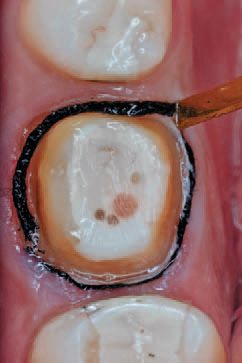
Fibercones from RTD Dental and Zircules Zirconium Nano-Filled Core Material from Clinician’s Choice.
Fig.1 shows the molar re-prepared for a full coverage ceramic restoration and the initial placement of a slightly wetted #000 Re-Cord Knitted Retraction Cord from Clinician’s Choice so it would easily slip into the sulcus without attaching to the gingival tissues.
Step 2
Fig. 2 shows the final placement of the #000 retraction cord, and because the preparation margins were quite subgingival, a double cord technique was used.

Fig. 3 shows placement of the Re-Cord #00, which was soaked in an aluminum sulphate hemostatic agent, Tissue Goo Hemostatic Gel from Clinician’s Choice, to help control any potential bleeding from manipulating the tissues.
As a general rule, any hemostatic agent should be removed prior to impressioning as hemostatic agents may compromise the setting reaction of polyvinyl siloxanes, and some may cause a discoloration of the dentin or result in a black residue (ferric sulphide).
Step 3
Fig. 5 shows the 5-7 second application of Detail Pre-Impression Cleansing Gel from Clinician’s Choice.
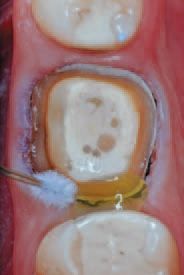
This is followed by a thorough water rinsing, which not only cleans the surface, but lowers the surface tension, making the impressioning easier.
The Affinity High Flow Light Body impression material is placed after the #00 Re-Cord is gently removed, making sure to keep the impression tip buried in the material while syringing (Fig. 6).
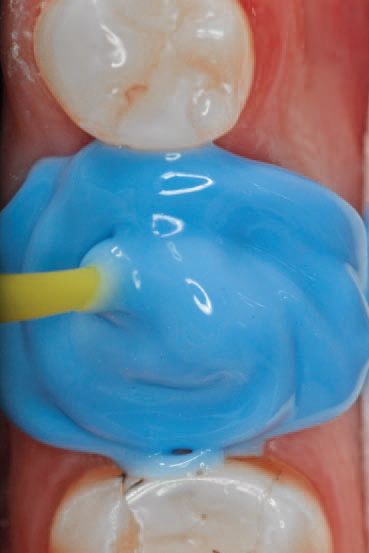
Step 4
It is critical that the dental assistant loads the Quad-Tray Xtreme with InFlex impression material in such a manner as to have the tray ready when the light body has been completely applied to the preparation.
The dual-arch tray should not be ready before nor should it be ready after, as both materials need to set simultaneously. The Quad-Tray Xtreme is inserted with the patient closing passively into the acquired centric relation and the impression material is allowed to set (Fig. 7).
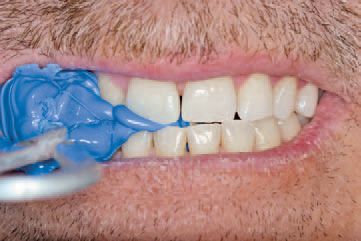
(Clinical Hint: A segmental biteregistration can be taken before the procedure starts and used later on the opposite side as a guide for the patient to bite into; this is especially useful when a mandibular block is placed.)
Step 5
The patient is then asked to open while holding the dual-arch tray against the prepared arch (Fig. 8)
.
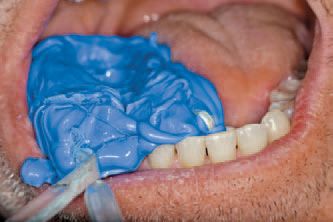
When using an aluminum tray, never remove the impression by torquing the handle of the tray, but gently remove it by gently rocking it laterally while holding it by its side. (Fig. 9)
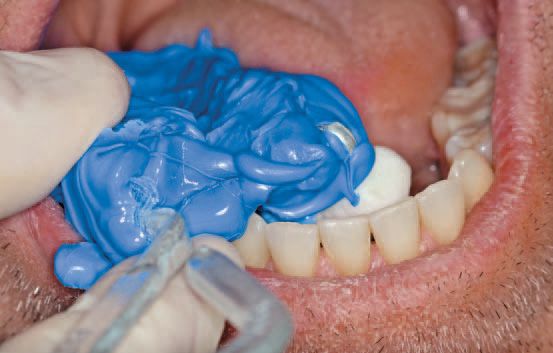
Step 6
Fig. 10 shows the final impression with all the margins captured well and the whole preparation captured in light body, which gives a more accurate die than when most of the light body is washed away because of the heavy hydraulics of some impression materials.
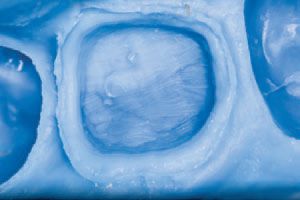
The final bonded ceramic restoration is shown in Fig. 11.

An inflexible dual-arch metal tray and an inflexible specifically designed dual-arch PVS material will systematically reduce the time required for seating and occlusally adjusting your final restoration.
ACTIVA BioACTIVE Bulk Flow Marks Pulpdent’s First Major Product Release in 4 Years
December 12th 2024Next-generation bulk-fill dental restorative raises the standard of care for bulk-fill procedures by providing natural remineralization support, while also overcoming current bulk-fill limitations.